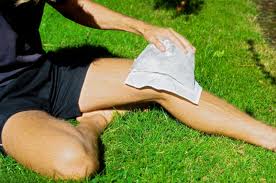Torn ligaments are also called ligament sprains as they occur from the stretching or tearing of a ligament due to an external force. Ligaments are tough fibrous bands that keep the bones intact and in place around the joint. Sprains occur when a bone is displaced from its normal position or is forced to move beyond its normal limit.
Common symptoms that may occur as a result of torn ligaments include swelling and bruising around the joint, in conjunction with joint pain that exacerbates with movement causing inability or difficulty to move the specific joint.
Treatment for ligament sprain or torn ligament involves rest, not taking part in vigorous activity for a period of time until symptoms get better, cold compresses, elevation and NSAIDs for pain. Complicated ligament injuries may require surgery.
There are three types of torn ligaments, which include:
- Grade 1 sprain – this occurs due to a slight stretch in the ligaments
- Grade 2 sprain – the affected ligament is partially torn
- Grade 3 sprain – the affected ligament is completely torn
Disclaimer: the material posted on this page on torn ligament injuries is for learning purposes only. To learn more about recognizing and managing injuries with first aid enrol in St Mark James training courses. 
Causes
Causes of torn ligaments include:
- Automobile accidents
- Falls
- Occupational injuries
- Sports injuries
- Stepping onto a lowered or uneven surface
- Diving into shallow pools
Signs and symptoms of torn ligaments
- Joint pain – knee, ankle, elbow, shoulder, wrist, hand, finger, hip, back, foot and neck pain
- Pain worsens with movement of the affected joint
- Swelling around the joint
- Stiffness of the joint – restricts movement
- Tenderness of the joint
- Joint warmth
- Inability to move the affected joint
Treatment
Treatment for torn ligament often depends on the severity and location of the affected joint. The doctor may prescribe rest, cold compresses, elevation and non-steroidal anti-inflammatory medication to ease pain. Surgery is only required for severe ligament sprains.
Treatment for ligament sprains includes the following steps:
- Rest – use walkers, crutches, canes or lings to support movement
- Apply cold compresses on the affected region for 20 minutes, at least twice a day
- Elevate the extremity of the affected limb, if possible
- Take nonsteroidal anti-inflammatory drugs to ease pain—ibuprofen, Ketoprofen, naproxen, celecoxib
- Take narcotic medication for moderate to severe joint pain (for short-term use only)
- Surgery may be required for severe sprains to repair damaged ligaments
Home care
Follow these home care steps to treat torn ligament:
- Apply cold compresses on the affected region with ice or an ice pack wrapped in a moist towel. Avoid directly applying ice on the skin
- Keep the extremity of the affected joint elevated as much as possible, especially while resting, above heart level
- Compress with an elastic gauze. Take the gauze off and re-wrap every 6 hours
- Rest the affected joint and support movement using a walker, crutches, a cane or a sling
- Apply a splint
- Resume exercising after 3 days of home treatment. Increase your activity gradually after 1-2 weeks. Avoid stressing the joint with vigorous activity too quickly
- Take over the counter pain medication such as acetaminophen or ibuprofen to reduce pain
- Take medication as prescribed by your doctor
Learn More
To learn more about muscle, joint and skeletal injuries and how to manage them enrol in a St Mark James first aid class with a credible provider (register here).
Related Video
http://www.youtube.com/watch?v=kNvtEMTF6YE
